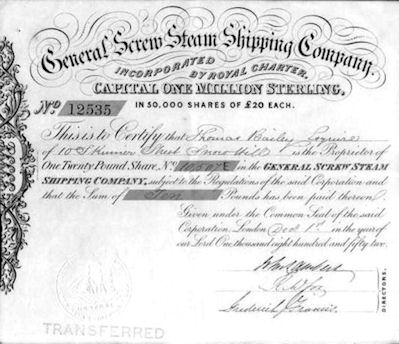The General Screw Steam Shipping Company

In 1847, the ‘City of London’ and the ‘City of Rotterdam’ screw steamers, of 270 tons burthen, and 30-horse power, the property of Mr. Laming, the Managing Director of the General Screw Steam Shipping Company, and a Mr. Richard Smith, a merchant from Rotterdam, who was residing in Manchester, and also was one of the Directors of the shipping company, were built for the purpose of superseding a line of sailing vessels, established by Mr. Laming in the trade with Holland, in 1816.
The performances of these two vessels exceeded the expectations of their projectors, and gave so much satisfaction to the merchants connected with Holland, that a Joint Stock Company was formed, and two new screw steamers were built, the ‘Lord John Russell’ and the ‘Sir Robert Peel’, of 320 tons burthen and 40-horse power.
These vessels were also very successful in their voyages, and their speed exceeded that of any screw steamers, of their power, then afloat. The attention of the Lords of the Admiralty was attracted to there performances, and at the request of the then, Earl of Auckland, a statement of the result of their working was laid before the Admiralty’s board.
In January, 1847, application was made to the Privy Council of the Board of Trade for a Royal Charter of Incorporation, which was at first refused, but at the special recommendation of the Board of Admiralty, it was granted in the month of August following, to this Company – under the name of “The General Screw Steam Shipping Company.” The conditions of the Charter having been completed, the new Company commenced the 15th July, 1848.
In the month of October, 1848, the ‘Sir Robert Peel’ made her first voyage between Liverpool, Constantinople, and London. She also made three voyages in 1849, and was followed in the same trade by the ‘Earl of Auckland’, of 450 tons burthen, and 70-horse power. The success of these vessels induced the Directors to place their new ships, the ‘Bosphorus’, ‘Hellespont’, and ‘Propontis’, of 560 tons burthen, and 80-horse power, on the Constantinople line, and with their five smaller vessels to carry on the trade between London and the ports of Rotterdam, Harlingen, and Dunkirk.
No casualty had ever happened to any of these vessels, and the most exact regularity as to time was maintained in all their voyages. The increased confidence of the public in the mode of propulsion that the Insurance at Lloyd’s on merchandise carried by the ‘Sir Robert Peel’ commenced the Constantinople line in 1848 was 70s. per cent., and in 1851 it was 20s. per cent.
Being successful in these speculations, it tendered for the performance of the mail service between England and the Cape of Good Hope.
During the year of 1850 the contract for the Mail Packet Service of the Cape of Good Hope, to be performed by screw propeller ships was submitted to public competition by the Board of Admiralty, and awarded to the General Screw Steam Shipping Company, at a sum of £30,750 per annum. For a monthly conveyance of the mails between England and the Cape. This service was started with the ‘Bosphorus’, on the 18th December 1850. Followed by the ‘Propontis’, ‘Helliespont’, and the ‘Harbinger’.

The government contract, which was formerly £30,700 for the mail service to the Cape of Good Hope, was increased to £45,000 per annum, and the steamers sailed from Plymouth on the 15th of every month, making the voyage to the Cape in 32 or 34 days; but with the larger class of ships this was cut down to 30 days.
At a board meeting held on the 6th March 1854 it was recommended that the Indian postal service should be abandoned due to the increase in the price of fuel, the difficulty of obtaining tonnage, and the increase also in the price of provisions and the price of labour. The revenue derived from freight and passengers had exceeded the original estimates which the Company launched into the Indian postal service; and if the expenses had remained within the bounds which the directors had good reason considered the abandonment; of the service, would in all probability had received a dividend. It was very evident that members of Her Majesty’s Government were entirely opposed to subsidy. These steamships consist of the ‘Hydaspes’, ‘Argo’, ‘Lady Jocelyn’, ‘Mauritius’, ‘Calcutta’, and ‘Indiana’.
The contract for the mail service to and from Australian mail had been renegotiated with the Postmaster-General. The service was to be an alternate monthly one from Southampton to Melbourne. The company were to go direct if they please and touch whatever they please, and use vessels of any power or tonnage. At Melbourne they could despatch the mails to Adelaide or Sydney, or they may go direct to Adelaide and then to Melbourne and Sydney. The only obligation upon this was reference to time. They were to have sixty-five days from Southampton to Melbourne and five days for sending the mails to the other ports; and for every day in excess of that period they would have to pay a penalty of £30.
The company’s new steamers, the ‘Golden Fleece’, ‘Jason’ and ‘Prince’, went into service for the Government and as the large ships came forward from the Indian service would also be employed.
